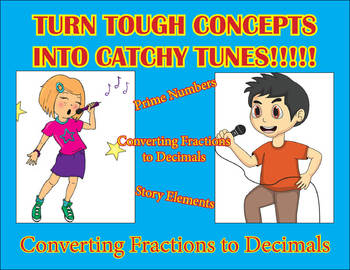Converting Fractions to Decimals song
Dr Jive
2 Followers
Description
Do your math students struggle with converting fractions to decimals and vice versa? This is a catchy song (to the tune of Edge of Glory) that will have your students converting fractions to decimals in no time!
The song teaches elementary math students the fraction and decimal forms of thirds, fourths, and fifths. I wrote this song after several weeks of students struggling to learn these fraction and decimal conversions. After the students learned the song in less than a week, it was smooth sailing from there.
Your zip file include a PDF of the song lyrics as well as an audio file with your truly singing (or at least attempting to sing) the song for you to give you a better idea of how the lyrics go with the music! Feel free to allow your students to add dance moves!
**This song can be purchased in a bundle at a discounted price**
- Dr Jive
The song teaches elementary math students the fraction and decimal forms of thirds, fourths, and fifths. I wrote this song after several weeks of students struggling to learn these fraction and decimal conversions. After the students learned the song in less than a week, it was smooth sailing from there.
Your zip file include a PDF of the song lyrics as well as an audio file with your truly singing (or at least attempting to sing) the song for you to give you a better idea of how the lyrics go with the music! Feel free to allow your students to add dance moves!
**This song can be purchased in a bundle at a discounted price**
- Dr Jive
Total Pages
1 page
Answer Key
Does not apply
Teaching Duration
1 hour
Report this resource to TPT
Reported resources will be reviewed by our team. Report this resource to let us know if this resource violates TPT’s content guidelines.
Standards
to see state-specific standards (only available in the US).
CCSS4.NF.C.5
Express a fraction with denominator 10 as an equivalent fraction with denominator 100, and use this technique to add two fractions with respective denominators 10 and 100. For example, express 3/10 as 30/100, and add 3/10 + 4/100 = 34/100.
CCSS4.NF.C.6
Use decimal notation for fractions with denominators 10 or 100. For example, rewrite 0.62 as 62/100; describe a length as 0.62 meters; locate 0.62 on a number line diagram.
CCSS4.NF.C.7
Compare two decimals to hundredths by reasoning about their size. Recognize that comparisons are valid only when the two decimals refer to the same whole. Record the results of comparisons with the symbols >, =, or <, and justify the conclusions, e.g., by using a visual model.


